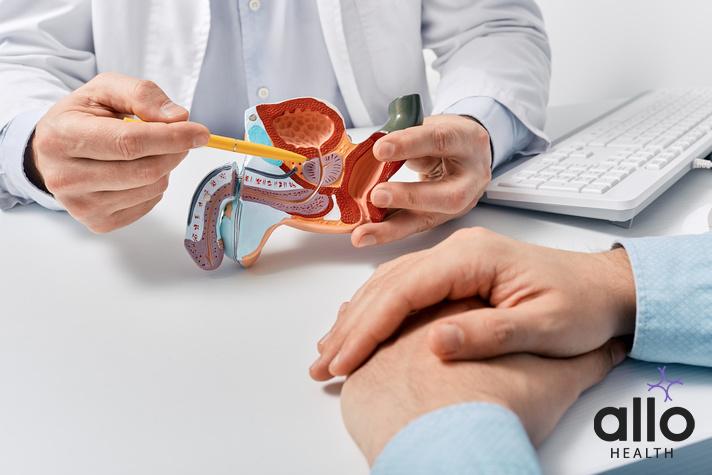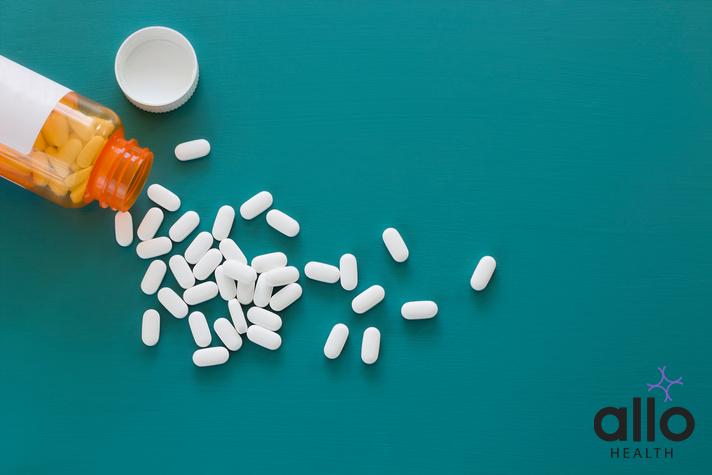Peyronie’s Disease: How to Straighten a Bent Penis

Allo Health is dedicated to personalized well-being, offering support and trusted information tailored to individual health goals. The platform emphasizes human-generated content, led by a distinguished medical team of experts, including physicians and sexual health specialists. Their commitment to credibility involves rigorous fact-checking, authoritative research, and continuous updates to ensure accurate, up-to-date information. Allo Health's unique approach goes beyond conventional platforms, providing expert-led insights and a continuous commitment to excellence, with user feedback playing a crucial role in shaping the platform's authoritative voice.

Dr. Aditi completed her undergraduate medical education at AJIMS, Mangalore, after which she worked in multi-speciality hospitals with COVID patients and in the Pain and Palliative medicine department. Driven by her experiences, she developed a keen interest in psychiatry. Dr. Aditi believes that mental health is just as, if not more important, than physical health.
Why This Was Upated?
Our experts continually monitor the health and wellness space, and we update our articles when new information became available.
Updated on 19 December, 2023
- Article was updated as part of our commitment to diversity, equity, and inclusion.

"The following blog article provides general information and insights on various topics. However, it is important to note that the information presented is not intended as professional advice in any specific field or area. The content of this blog is for general educational and informational purposes only.
Book consultation
The content should not be interpreted as endorsement, recommendation, or guarantee of any product, service, or information mentioned. Readers are solely responsible for the decisions and actions they take based on the information provided in this blog. It is essential to exercise individual judgment, critical thinking, and personal responsibility when applying or implementing any information or suggestions discussed in the blog."
If you’re experiencing penile curvature, you’re not alone. While it’s a relatively common condition, it can cause significant physical and emotional discomfort and can significantly affect your sexual health. If you’re struggling with a bent penis, understanding the causes, and treatment options is essential.
In this article, we’ll look into what a bent penis may signify and what treatment options are available to straighten it.
What Does a Bent Penis Mean?
- A bent or curved penis is also known as Peyronie’s disease, is a condition where the penis develops a noticeable curvature or deformity.
- This curvature can occur during an erection and may be caused by the formation of scar tissue (plaque) inside the penis.
- Peyronie’s disease can result in discomfort, pain, or difficulties with sexual activity or sexual intercourse.
- Some degree of curvature is normal, but when it becomes severe or interferes with sexual function, it may indicate Peyronie’s disease and should be evaluated by a qualified health provider.
Symptoms of Peyronie’s Disease
- Penile curvature: The most common and noticeable symptom is a significant curvature or bend in the penis, particularly during erections.
- Pain (painful erections): Some individuals may experience pain, particularly during erections. This pain can vary from mild to severe.
- Erectile dysfunction: Peyronie’s disease can lead to difficulties achieving or maintaining an erection, which can affect sexual function.
- Shortening of the penis: In some cases, there may be a noticeable shortening of the penis due to the curvature.
- Plaque formation: A hard lump or plaque may be felt under the skin of the erect penis. This is caused by the accumulation of scar tissue.
- Difficulty with intercourse: The curvature and pain associated with Peyronie’s disease can make sexual intercourse challenging or even painful.

If there is a slight bend in your penis that does not cause any pain, discomfort, or inconvenience during sexual activity, it is unlikely to be a concern.
Causes of Peyronie’s Disease:
- Trauma or injury: Peyronie’s disease often develops after some form of trauma or injury to the penis. This could be from vigorous sexual activity, an accident, or even a medical procedure.
- Microscopic bleeding: After an injury, there may be tiny areas of bleeding inside the penis. This can lead to the formation of scar tissue.
- Genetics: There may be a genetic component that makes some individuals more prone to developing Peyronie’s disease.
- Connective tissue disorders: Conditions that affect connective tissues, such as Dupuytren’s contracture, may increase the risk of developing Peyronie’s disease.
- Age: While Peyronie’s disease can affect men of any age, it is more commonly seen in older men.
- Certain health conditions: Peyronie’s disease has been associated with certain health conditions like diabetes.
- Medications: Some medications, particularly those that affect blood flow, may contribute to the development of Peyronie’s disease.
The exact cause of Peyronie’s disease isn’t always clear, and it can vary from person to person. If someone suspects they have Peyronie’s disease or is experiencing symptoms, it’s advisable to seek medical advice from a healthcare professional for proper evaluation and guidance.
How Do I Straighten My Penis: Treatment Options
Watchful Waiting:
In some cases, especially if the symptoms of Peyronie’s disease are mild and not causing significant distress, doctors may recommend a period of watchful waiting. This involves monitoring the condition without active intervention.
Medications
- Oral medications: Certain medications, like collagenase clostridium histolyticum, may be prescribed to help break down the plaque and reduce curvature.
- Topical Verapamil or Pentoxifylline: These medications may be applied directly to the affected area to help reduce the size of the plaque and improve symptoms.
Penile Traction Devices
These devices are worn on the penis and apply gentle, consistent traction to help straighten the curvature over time.
Injections
Verapamil or interferon alfa-2b: These medications can be injected directly into the plaque to help soften it and reduce penis curvature.
Shockwave therapy: Low-intensity shockwaves are applied to the penis, which may help break down the plaque and improve blood flow.
Surgery
- Nesbit Procedure: This surgery involves removing or excising a portion of tissue from the opposite side of the penis to straighten it.
- Grafting or Implants: In severe cases, grafts or implants may be used to correct the curvature.
Penile Prosthesis:
In cases of severe Peyronie’s disease with significant erectile dysfunction, a penile prosthesis may be implanted to allow for erections.
Combined Therapies:
Some doctors may recommend a combination of treatments, such as medication along with traction therapy, to achieve better results.
Physical Therapy:
Techniques like ultrasound therapy or vacuum erection devices, when administered by a trained therapist, may help improve symptoms.
Lifestyle Changes:
Maintaining a healthy lifestyle with regular exercise, a balanced diet, and avoiding smoking and excessive alcohol consumption can support overall penile health.
The choice of treatment depends on the severity of the condition, the individual’s overall health, and their preferences. A healthcare provider will evaluate the specific case and recommend the most appropriate course of action.

When Should You Seek Medical Attention?
- It’s advisable to consult a doctor promptly upon observing any indications or symptoms of Peyronie’s disease.
- Seeking early treatment offers the highest likelihood of ameliorating the condition or halting its progression.
- If you’ve been dealing with the condition for an extended period, and you’re experiencing discomfort due to pain, curvature, changes in length, or other deformities, it’s recommended to seek expert advice from health care professionals, for your well-being and that of your partner.
Key Takeaways
- Peyronie’s disease, characterized by penile curvature, is a common condition causing physical and emotional discomfort and can negatively impact your mental health.
- Understanding its causes, treatment options, and recovery process is crucial for those dealing with a bent penis.
- Peyronie’s disease, or a bent penis, arises from the development of scar tissue (plaque) inside the penis, leading to noticeable curvature.
- Symptoms include penile curvature, pain during erections, erectile dysfunction, shortening of the penis, plaque formation, and difficulties with intercourse.
- Causes range from trauma or injury to genetic predisposition, connective tissue disorders, age, certain health conditions, and medications.
- Treatment options include watchful waiting, medications, penile traction devices, injections, surgery, penile prosthesis, combined therapies, physical therapy, and lifestyle changes, with early medical attention being crucial for the best outcomes.
Frequently Asked Questions
Q: What is Peyronie’s Disease?
A: Peyronie’s disease is a condition where the penis develops a noticeable curvature or deformity, often causing discomfort and affecting sexual function.
Q: Will Peyronie’s Disease affect sexual performance?
A: Peyronie’s disease can potentially impact sexual performance due to penile curvature, pain, and potential difficulties with achieving or maintaining an erection. It’s advisable to seek medical advice for personalized guidance and treatment options.
Q: Is Peyronie’s Disease common?
A: Yes, it is relatively common. It’s estimated that up to 13% of men may experience some form of penile curvature.
Q: Can Peyronie’s Disease be treated?
A: Yes, there are various treatment options available, including medications, penile traction devices, injections, shockwave therapy, surgery, physical therapy, and lifestyle changes. Treatment for Peyronie’s disease should be done by health professionals only.
Q: Are there any natural remedies for Peyronie’s Disease?
A: Some individuals may explore natural remedies, but it’s crucial to consult a healthcare provider for guidance, as these approaches may not be supported by strong scientific evidence.






































